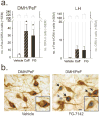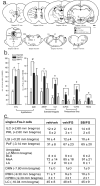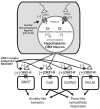Orexin 1 receptors are a novel target to modulate panic responses and the panic brain network
- PMID: 22554617
- PMCID: PMC3472124
- DOI: 10.1016/j.physbeh.2012.04.016
Orexin 1 receptors are a novel target to modulate panic responses and the panic brain network
Abstract
Background: Although the hypothalamic orexin system is known to regulate appetitive behaviors and promote wakefulness and arousal (Sakurai, 2007 [56]), this system may also be important in adaptive and pathological anxiety/stress responses (Suzuki et al., 2005 [4]). In a recent study, we demonstrated that CSF orexin levels were significantly higher in patients experiencing panic attacks compared to non-panicking depressed subjects (Johnson et al., 2010 [9]). Furthermore, genetically silencing orexin synthesis or blocking orexin 1 receptors attenuated lactate-induced panic in an animal model of panic disorder. Therefore, in the present study, we tested if orexin (ORX) modulates panic responses and brain pathways activated by two different panicogenic drugs.
Methods: We conducted a series of pharmacological, behavioral, physiological and immunohistochemical experiments to study the modulation by the orexinergic inputs of anxiety behaviors, autonomic responses, and activation of brain pathways elicited by systemic injections of anxiogenic/panicogenic drugs in rats.
Results: We show that systemic injections of two different anxiogenic/panicogenic drugs (FG-7142, an inverse agonist at the benzodiazepine site of the GABA(A) receptor, and caffeine, a nonselective competitive adenosine receptor antagonist) increased c-Fos induction in a specific subset of orexin neurons located in the dorsomedial/perifornical (DMH/PeF) but not the lateral hypothalamus. Pretreating rats with an orexin 1 receptor antagonist attenuated the FG-7142-induced anxiety-like behaviors, increased heart rate, and neuronal activation in key panic pathways, including subregions of the central nucleus of the amygdala, bed nucleus of the stria terminalis, periaqueductal gray and in the rostroventrolateral medulla.
Conclusion: Overall, the data here suggest that the ORX neurons in the DMH/PeF region are critical to eliciting coordinated panic responses and that ORX1 receptor antagonists constitute a potential novel treatment strategy for panic and related anxiety disorders. The neural pathways through which ORX1 receptor antagonists attenuate panic responses involve the extended amygdala, periaqueductal gray, and medullary autonomic centers.
Copyright © 2012 Elsevier Inc. All rights reserved.
Figures






Similar articles
-
A key role for orexin in panic anxiety.Nat Med. 2010 Jan;16(1):111-5. doi: 10.1038/nm.2075. Epub 2009 Dec 27. Nat Med. 2010. PMID: 20037593 Free PMC article.
-
Orexin neurons in the hypothalamus mediate cardiorespiratory responses induced by disinhibition of the amygdala and bed nucleus of the stria terminalis.Brain Res. 2009 Mar 25;1262:25-37. doi: 10.1016/j.brainres.2009.01.022. Epub 2009 Jan 27. Brain Res. 2009. PMID: 19368849
-
Serotonergic systems associated with arousal and vigilance behaviors following administration of anxiogenic drugs.Neuroscience. 2005;133(4):983-97. doi: 10.1016/j.neuroscience.2005.03.025. Neuroscience. 2005. PMID: 15916857
-
Role of medial hypothalamic orexin system in panic, phobia and hypertension.Brain Res. 2020 Mar 15;1731:145942. doi: 10.1016/j.brainres.2018.09.010. Epub 2018 Sep 8. Brain Res. 2020. PMID: 30205108 Review.
-
Orexin/hypocretin receptor modulation of anxiolytic and antidepressive responses during social stress and decision-making: Potential for therapy.Brain Res. 2020 Mar 15;1731:146085. doi: 10.1016/j.brainres.2018.12.036. Epub 2018 Dec 24. Brain Res. 2020. PMID: 30590027 Free PMC article. Review.
Cited by
-
Orexin Receptor Antagonists as Emerging Treatments for Psychiatric Disorders.Neurosci Bull. 2020 Apr;36(4):432-448. doi: 10.1007/s12264-019-00447-9. Epub 2019 Nov 28. Neurosci Bull. 2020. PMID: 31782044 Free PMC article. Review.
-
Etiology, triggers and neurochemical circuits associated with unexpected, expected, and laboratory-induced panic attacks.Neurosci Biobehav Rev. 2014 Oct;46 Pt 3:429-54. doi: 10.1016/j.neubiorev.2014.07.027. Epub 2014 Aug 15. Neurosci Biobehav Rev. 2014. PMID: 25130976 Free PMC article. Review.
-
DLK1 Expressed in Mouse Orexin Neurons Modulates Anxio-Depressive Behavior but Not Energy Balance.Brain Sci. 2020 Dec 12;10(12):975. doi: 10.3390/brainsci10120975. Brain Sci. 2020. PMID: 33322758 Free PMC article.
-
A selective orexin-1 receptor antagonist attenuates stress-induced hyperarousal without hypnotic effects.J Pharmacol Exp Ther. 2015 Mar;352(3):590-601. doi: 10.1124/jpet.114.220392. Epub 2015 Jan 12. J Pharmacol Exp Ther. 2015. PMID: 25583879 Free PMC article.
-
Machine learning models to predict ligand binding affinity for the orexin 1 receptor.Artif Intell Chem. 2024 Jun;2(1):100040. doi: 10.1016/j.aichem.2023.100040. Epub 2023 Dec 20. Artif Intell Chem. 2024. PMID: 38476266 Free PMC article.
References
-
- Sakurai T, Amemiya A, Ishii M, Matsuzaki I, Chemelli RM, Tanaka H, et al. Orexins and orexin receptors: a family of hypothalamic neuropeptides and G protein-coupled receptors that regulate feeding behavior. Cell. 1998;92:573–85. - PubMed
-
- Suzuki M, Beuckmann CT, Shikata K, Ogura H, Sawai T. Orexin-A (hypocretin-1) is possibly involved in generation of anxiety-like behavior. Brain Res. 2005;1044:116–21. - PubMed
-
- Samson WK, Taylor MM, Follwell M, Ferguson AV. Orexin actions in hypothalamic paraventricular nucleus: physiological consequences and cellular correlates. Regul Pept. 2002;104:97–103. - PubMed
Publication types
MeSH terms
Substances
Grants and funding
LinkOut - more resources
Full Text Sources
Other Literature Sources

